LSI Keywords: Why They Matter and How to Use Them
Latent Semantic Indexing (LSI) is a way in which search engines index and retrieve pages. LSI keywords are words or phrases that you can use to add more context to your content and help search engines index it.
But before we get into more details, here’s a disclaimer:
LSI keywords are not technically a type of keyword. In fact, LSI keywords don’t exist according to Google.
So, why are we writing a post on LSI keywords?
Because it’s just a popular term that is actually used to refer to synonyms of a primary keyword or related keywords, both of which are extremely important for SEO.
Now that we’ve cleared, let’s understand how search engines work and why related keywords are important.
Search engines crawl each page on your website, try to understand it, and index each page under relevant categories. This is where LSI keywords can help.
LSI keywords are nothing but variations of your primary or target keyword. Let’s say your primary keyword is “Ruby”, which can mean:
- A gemstone
- A name
- A programming language
- A song by Kaiser Chiefs
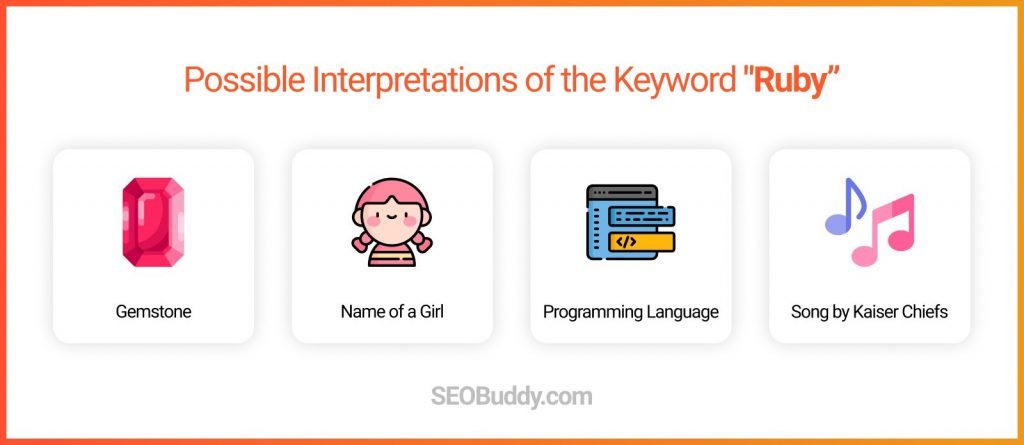
When you add another word or phrase to it like “a red Ruby” you provide the context to Google that you’re talking about a gemstone.
Now that we’ve got that cleared, let’s talk more about LSI keywords. In this post, we’ll cover the following details:
- What are LSI keywords?
- How to find LSI keywords for your posts
- How to use LSI keywords in your content
Ready to learn?
Keep reading.
What Are LSI Keywords?
LSI keywords are variations or synonyms of your target keyword that provide more information to search engines about your content.
Earlier, Google would only look at how many times you’ve used the main keyword in your content. At that time, target keyword density was the main concern for marketers.
However, that’s not the case anymore. Google scans your web page to check if you’ve used other keywords related to your primary keyword. This is because these additional keywords provide some extra information that is not conveyed just by the main keyword.
For instance, let’s say you write a blog post about “cheesecake.” In this case, Google will scan your content, title, meta description, URL, and image alt text for LSI keywords like “no-bake,” “new york cheesecake,” “baked cheesecake,” and “cheesecake price.”
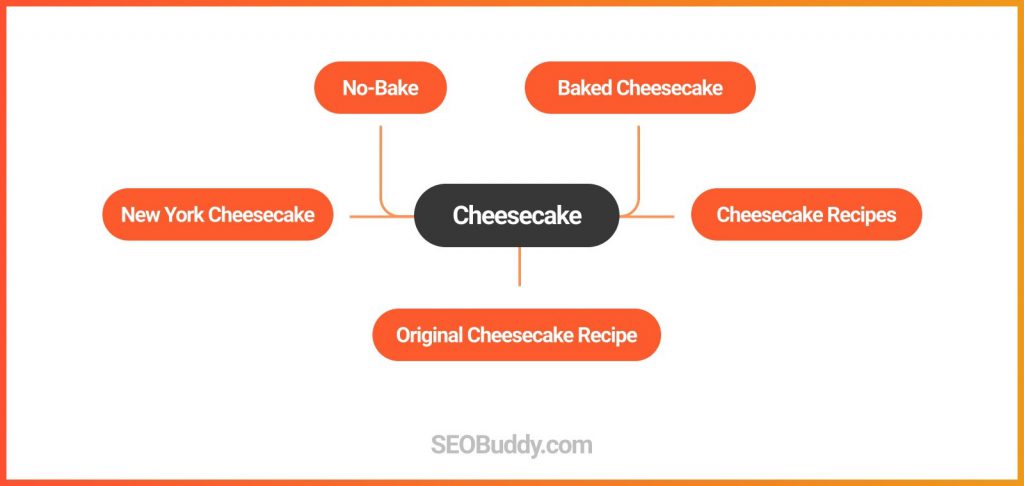
If you look at it closely, all the LSI keywords tell Google what exactly the post is about. While “cheesecake” can be the main keyword, phrases like “no-bake” and “New York Cheesecake” add more context.
Google even revealed their technique to discover semantically meaningful topics entered in search queries. One of the ways for them is to generate topics from words that occur together.

Why Are LSI Keywords Important?
LSI keywords are important because they help search engines better understand and index your content. This means that your pages will have a higher chance of showing up in the search results for relevant queries.
Keep in mind that Google understands the meaning or context of an article by establishing relationships between the various keywords used in it. LSI keywords are formed by adding relevant words or phrases to your primary keyword, thus providing more information on the subject.
If you know which keywords Google wants to find an article for a certain topic, you can use them to add more value to your content. Not only will it make your post more relevant, but it will also make it more likely to rank in the SERP for your targeted keyword.
Get the full SEO Checklist and start taking ALL the steps you need to in order to rank at the top of Google.

John Abott The SEO Checklist by SEOBuddy is awesome. It doesn’t just tell you what you need to do, it walks you through the process.
Are All LSI Keywords Synonyms?
The simple answer to this question is NO.
They can be synonymous sometimes but that’s not always the case. Typically, an LSI keyword could be any term that is closely related to your main keyword.
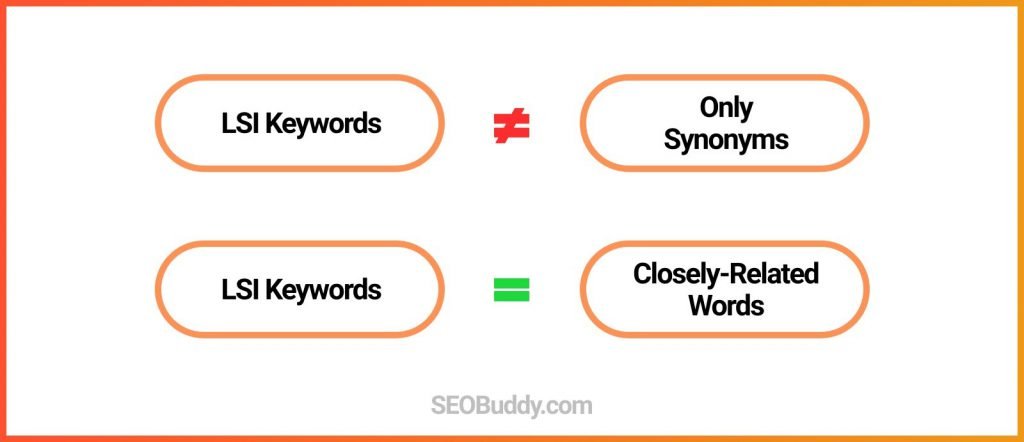
For instance, the LSI keywords for “yoga” would be “stress,” “meditation,” “poses,” and “breathing.” They aren’t synonyms but are generic terms related to yoga.
Next, here’s how to find LSI keywords.
How to Find the Right LSI Keywords to Add In Your Blog Posts
It’s evident that adding LSI keywords can give Google a better idea of what your content is about. That, in turn, can help you get better rankings.
But how can you find the right LSI keywords?
In this section, let’s discuss different ways you can find LSI keywords to include in your blog posts:
1. Check Related Searches in Google
The easiest method to find LSI keywords for any post is to enter your main keyword in the search bar. Next, scroll down to the “Related Searches” section. If you’re writing about “face masks,” you might also want to include information regarding its price, fabric, and washability.
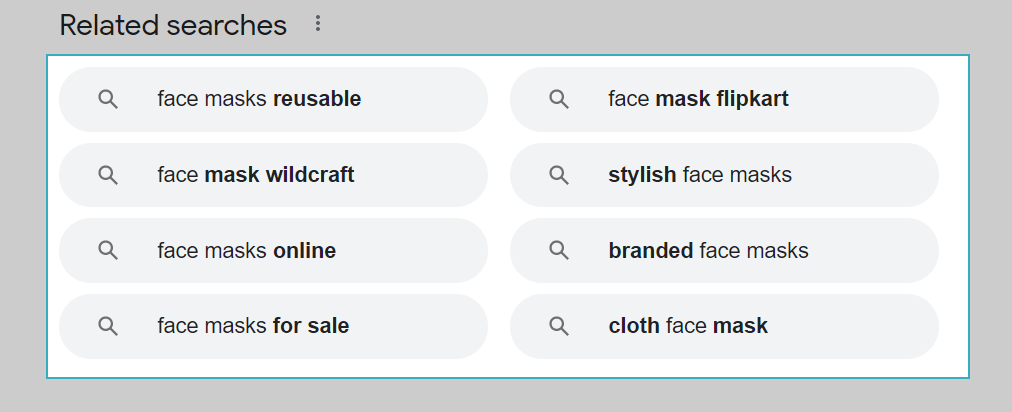
For any search query, the related searches will tell you what you should include in your content along with the main keyword. In addition to this, you can also check out the “People Also Ask section” to get a better idea of the search intent.

The only issue with this method is that you’ll only get 7-8 LSI keywords for your content. If you want an extensive LSI keywords list, you should look at the other methods listed.
2. LSIGraph
A quick way to get a list of LSI keywords is to use a free tool like LSIGraph. All you need to do is add your main keyword in the search bar.
Let’s try adding the main keyword, “stilettos.”

When you press on the “generate” button on the right, here are the results you get. The tool also shows the search volume, trend, CPC, and other details.
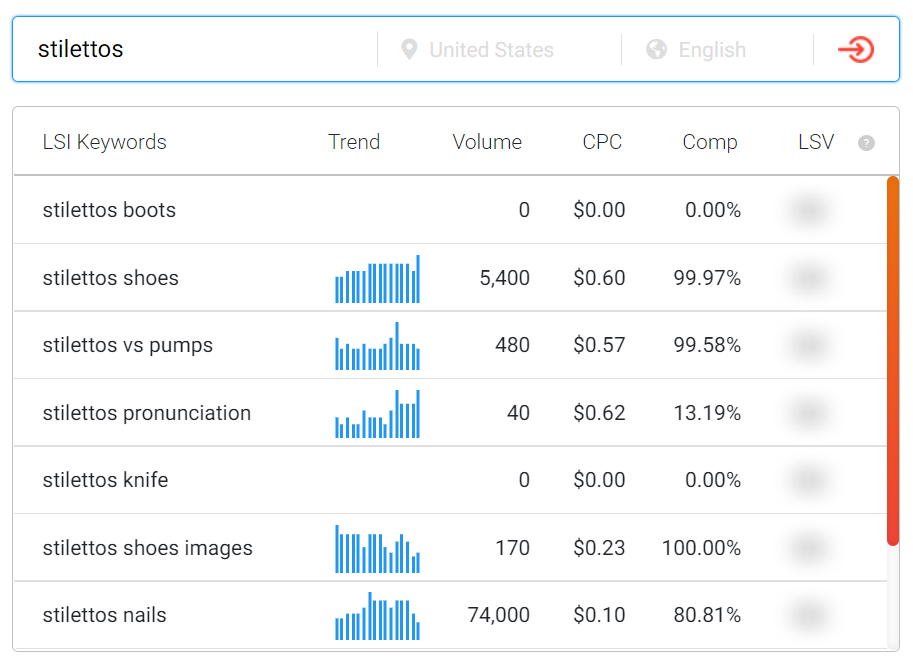
Please note that the keywords aren’t added in any particular order. So, don’t assume the ones listed at the top should be used more.
3. Google Autocomplete
Another easy way to discover LSI terms for free is through the autocomplete feature on Google. Whenever you type your query, Google provides multiple suggestions.
For instance, here is what you see on Google when you enter the keyword, “Italy wine.” The words given in bold are the ones you should aim to add in your post.
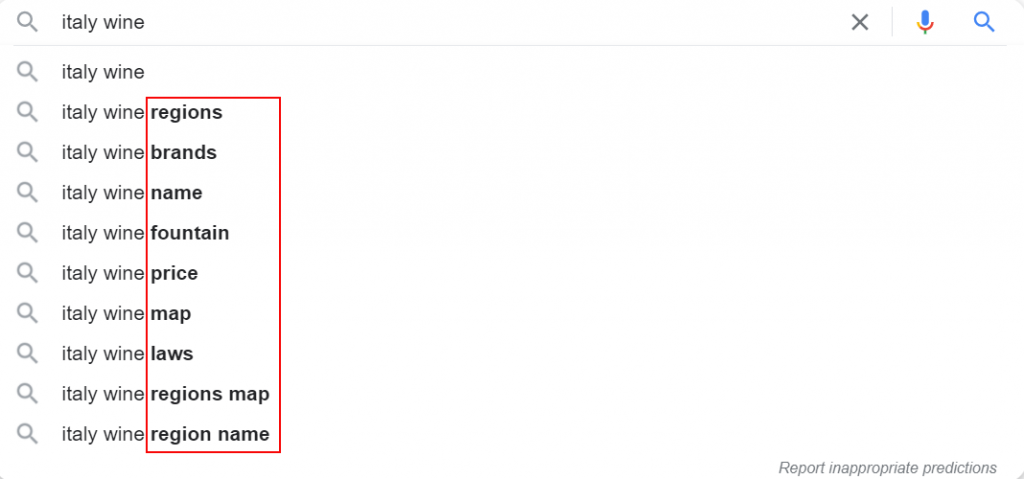
The phrases added in bold are the ones people are searching for when they want any information related to “Italy wines.”
4. Snippets
The third way to find LSI keywords via Google is through snippets that you see in the SERPs. Google highlights some terms in bold that match your keyword.
For instance, if you enter the main keyword, “sunflower oil,” Google also highlights the phrase, “sunflower seed” in bold.

These two terms are closely related, so you can add “sunflower seed” to your list of LSI keywords for the keyword, “sunflower oil.”
These are the LSI keywords that Google wants you to add to your content. You can easily find 7-8 keywords by checking out different pages on the SERP.
5. Google Image Tags
Another less obvious trick to find LSI keywords for free is via Google Images. If you know how to use it well, it is actually a goldmine of LSI keywords.
Here’s how you can use it.
First, add your keyword in Google images. For this example, let’s go ahead with the keyword, “off-page.”
As you can see in the screenshot below, Google shows related terms at the top panel. These are all LSI keywords that you can use to optimize your content.

How to Use LSI Keywords in Your Content
Once you find the right LSI keywords for your content, the next step is to add them. That brings us to the following questions:
- How should you add LSI keywords naturally in your posts?
- Where should you add LSI keywords in your content?
In this section, let’s talk about how and where to add LSI keywords so that Google can find them easily, yet it doesn’t seem forced.
How To Naturally Use LSI Keywords In Your Writing
When you check out the list of LSI keywords from an automatic keyword generator tool, you may realize that they are not easy to add. Sometimes they may not make sense grammatically or may just be difficult to add in the natural content flow.
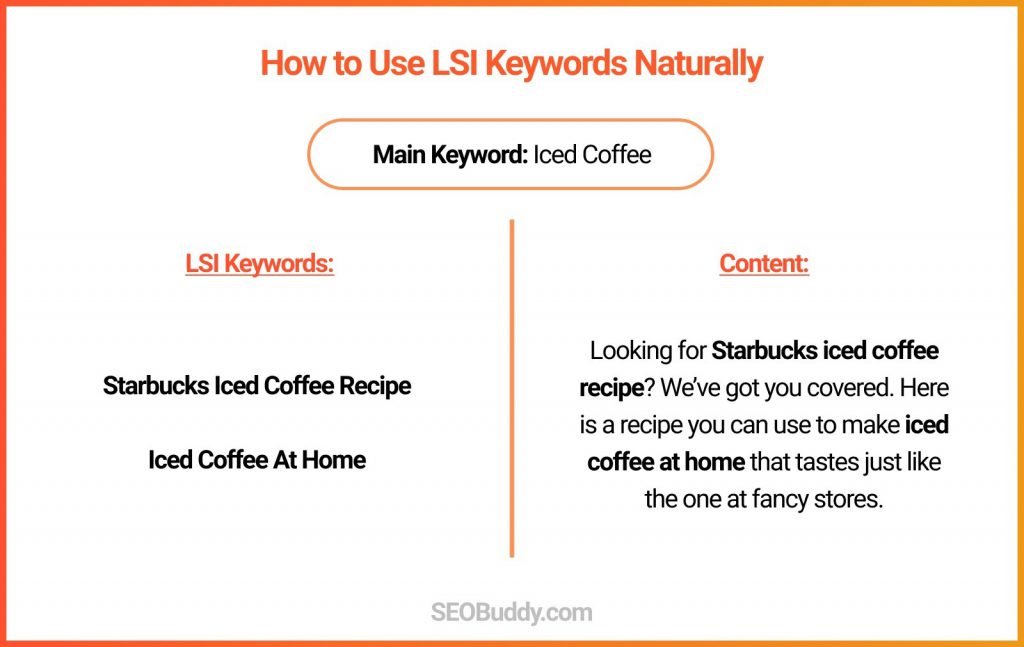
But you can’t just add them at random places and hope readers don’t realize that you are trying to optimize your post.
What’s the alternative?
In such instances, what should you do?
Here are a few tricks you can use to insert LSI keywords naturally in your content:
- Break up bigger content sections into smaller ones and add your LSI keywords as sub-headings.
- Add questions related to LSI keywords to start a new point.
- Add definitions of LSI keywords if it is relevant to your content.
Let’s understand it with the help of an example. Let’s say, our LSI keyword is “Automatic soap dispenser.” Here is how you can use it in different ways in your content:
- Statements: the biggest benefit of an automatic soap dispenser is that you can dispense soap in a touch-free manner.
- Questions: Want an automatic soap dispenser for your bathroom?
- Sub-Headings: How to Make Automatic Soap Dispenser
Don’t these sentences seem natural? In this way, you can manage to include LSI keywords and provide value to the reader.

Now it’s time to discover the other 102 steps that will get more organic traffic flowing to your website. Get the SEO Checklist here.
Want to get a sneak peek of what it looks like?
Enter your email and get a free demo version of the SEO Checklist.
Where Should You Add LSI Keywords In Your Blog Posts?
Once you know the right LSI keywords, you should begin to add them throughout your post. While adding them naturally in the flow of content is a great idea, you shouldn’t stop at that. You should also add your LSI keywords at the following places:
- Meta descriptions
- Title tag
- Image alt tags
- H2 and H3 tags
- URL
- Main content
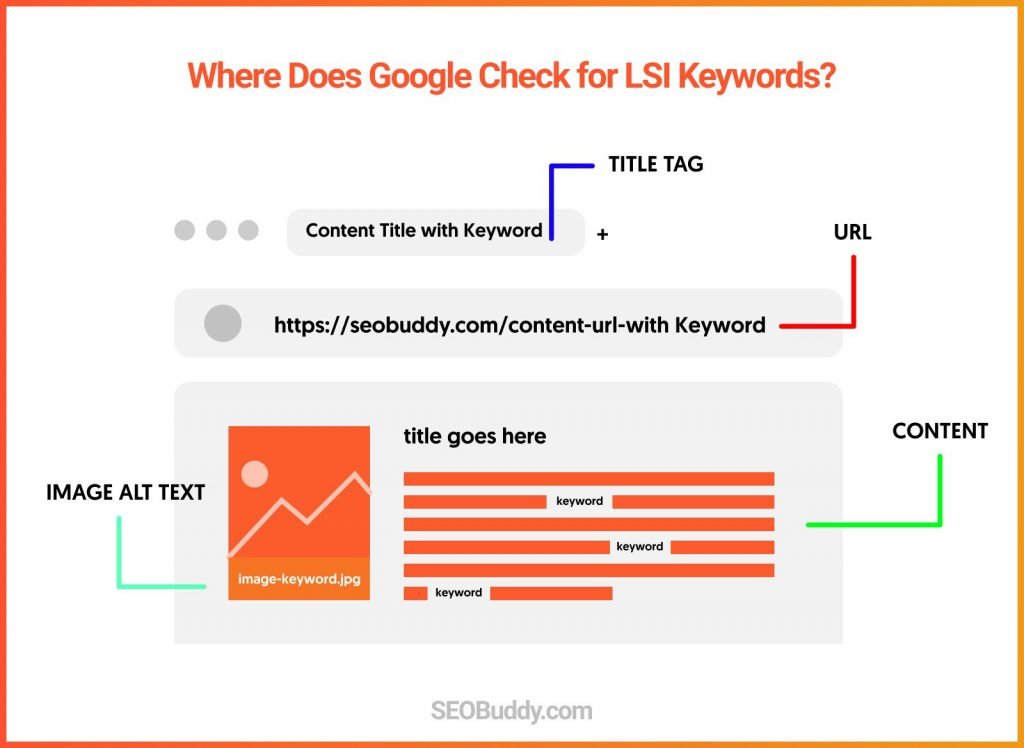
Google checks all of these places to understand the context of an article. That’s why you should add LSI keywords there.
However, don’t try to stuff them just for the sake of it. Instead, add them wherever naturally possible. Additionally, in your content, you should aim to sprinkle them in different sections organically.
Typically, the ideal density for the main keyword is 1.5%. However, for LSI keywords, there isn’t any specific rule or estimate to go ahead with. You can add them wherever it is naturally possible.
FAQs
1. How do I find LSI keywords?
To find LSI (latent semantic indexing) keywords for your content, you can use the following tips:
- Look at the “Related Searches” section on Google
- Use Google’s Keyword Planner Tool
- Use LSI Graph for research
- Use the Keyword Difficulty Tool by Alexa
2. What is LSI where it is used?
Latent semantic indexing or latent semantic analysis is a technique used by Google and other search engines to understand and index pages based on their content. Search engines look for semantically related keywords or phrases on a page to draw relationships and get the whole context.
LSI keywords are phrases that Google sees as related semantically to a specific topic. For instance, if you’re writing an article about cars, the LSI keywords for it are likely to be automobiles, tires, roads, and vehicles.
You should use LSI keywords at the following places to improve your chances of getting ranked in the SERPs:
- Meta description
- Content
- PPC and other marketing campaigns
- Image file names
Just like you do with primary keywords, maintain a good keyword density for LSI keywords as well.
3. What is the full form of LSI?
The full form of LSI is Latent Semantic Indexing. It’s a special method that finds relationships between concepts and words used in a content piece via certain mathematical techniques.
Latent semantic indexing technique is used by search engines to understand and index content on web pages.
4. What is an LSI keyword generator?
LSI keyword generator tools can help you find LSI keywords or related keywords for the main keyword in a copy. You can use it to find words or phrases that are closely related to your target keyword and can help add more context to your content.
5. What is an LSI keyword example?
LSI keywords are words or phrases that are closely related to the main keyword. These do not necessarily have to be synonyms, but can simply be semantically related keywords.
For example, if your main keyword is “jacket,” your LSI keywords are likely to be the following:
- Winter
- Reversible
- Puffer
- Padded
You will notice that these do not mean the same thing as the primary keyword, but provide more information about the keyword. So, LSI keywords enrich the content by providing more information and that is why you should use these in all your web content.
Summing It Up
Understanding how LSI keywords can help you boost your search rankings can give you an edge over your competitors. Plus, it is super easy to find them and integrate them into your content.
It’s all about doing some smart optimization to get ahead of your competition. If you do your LSI keyword research right, you’ll see that your post shows better results in SEO optimization tools.
Ready to get started with LSI keyword research now? Also, check out our SEO checklist to help you with other aspects of SEO and improve your rankings.
Do you have any questions about adding LSI keywords to your content? Please add them in the comments section below.




This website is one of the best example of the LSI keyworded website.
Amazing article, it helped me a lot!